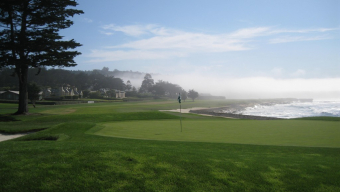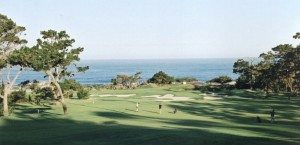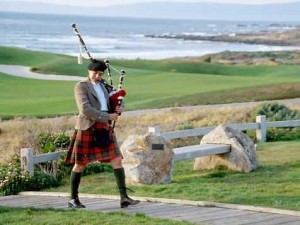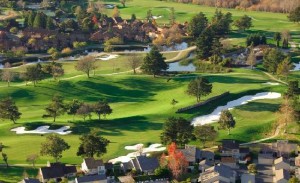Where’s the best place to play golf on the West Coast? We’ll give you hundreds of choices.
Golferswest.com continues its annual assessment of the Top Five courses to play within 12 West Coast states and British Columbia. Today, the 25-part series focuses on: California/Monterey.
NO. 1 COURSE: PEBBLE BEACH
LOCATION: Pebble Beach
DIRECTIONS FROM SAN JOSE: Take Highway 101 South to Highway 156/ Monterey Peninsula exit. Follow Highway 156 to Castroville/ Highway 1 South. Follow Highway 1 South approximately 18 miles and take the 68 West (Pebble Beach/ Pacific Grove) exit. At the exit, go straight across through the traffic light, then bear right to the Pebble Beach entry gate. After passing through the entry gate, branch left and follow 17-Mile Drive approximately 2.5 miles to Palmero Way. Make a left turn on Palmero Way and follow the signs to the Pebble Beach Golf Links. Approximate Travel Time: 1-1.5 hours
PHONE: 800-694-9300
GREEN FEES: Rates vary, check web site: pebblebeach.com
OPENED: 1919 (Architects: Douglas Grant and Jack Neville)
LAYOUT: Par 72, 6,828 yards (five tee positions)
LOWDOWN: Since 1919, golfers have relished this spectacular ocean side course, considered the greatest public golf course in America, and the site of five U.S. Opens.
The game of golf is at its worldwide best at Pebble Beach Resorts. Whether you are anticipating playing the most exciting closing hole in golf, finally mastering the toughest hole on the PGA Tour or simply relishing walking in the footsteps of golf’s greatest names, Pebble Beach Golf Links is a legend.
The course hugs the rugged coastline, providing wide-open vistas, cliffside fairways and sloping greens.
SIGNATURE HOLE: No. 18, par-5, 543 yards. The 18th hole is a medium length par 5 with Pacific Ocean all along the left. What may be the greatest closing hole in golf was originally an unremarkable par 4. Almost 200 yards was added to the hole in 1922. This unique hole also features a tree in the middle of the fairway and a long 100-plus yard bunker running along the ocean from the green, guarding the left side.
NO. 2 COURSE: SPYGLASS HILL
LOCATION: Carmel
DIRECTIONS FROM MONTEREY AIRPORT: Exit the airport and turn right onto Highway 68 West. Proceed on Highway 68 until it merges with Highway 1 South. Once on Highway 1 South, take the 68 West (Pebble Beach/ Pacific Grove) exit. At the exit, go straight across through the traffic light, then bear right to the Pebble Beach entry gate. After passing through the guard gate, branch left and follow 17-Mile Drive approximately 2.5 miles to Palmero Way. Make a left turn on Palmero Way and follow the signs to The Lodge at Pebble Beach.
PHONE: 800 654-9300
GREEN FEES: Rates vary, check web site: pebblebeach.com/golf/spyglass-hill-golf-course
OPENED: 1966 (Architect: Robert Trent Jones Sr.)
LAYOUT: Par 72, 6,960 yards (four tee positions)
LOWDOWN: Spyglass Hill Golf Course takes its name from Robert Louis Stevenson’s classic novel, Treasure Island, published in 1883. Local legend maintains that Stevenson once wandered the Spyglass area gathering ideas for his novels. With this in mind, Robert Trent Jones Sr. set about creating a treasure of his own.
Opened in 1966, Spyglass Hill Golf Course features two distinctly different kinds of terrain that influence the way the holes look and play. The first five holes roll through sandy seaside dunes challenging you to carefully pick the safest path. The following 13 holes are cut through majestic pines with elevated greens and strategically placed bunkers and lakes to grab the errant shot. Hole names such as “Black Dog” and “Billy Bones” are hints for the unwary.
Spyglass is rated one of the toughest courses in the world from the championship tees, boasting a course rating of 75.5 and a slope rating of 147. The PGA Tour consistently lists Spyglass Hill’s holes 6, 8 and 16 among the toughest on the Tour, and during the 1999 United States Amateur, the stroke average of the field during medal play was in excess of 79.
SIGNATURE HOLE: No. 16, par-4, 476 yards. Nicknamed “Black Dog”, a drive too long could run through the fairway. A tree, which cannot be seen from the tee, blocks the right side. However, if you make it past the tree, you have a wide open shot to the green. It is best to play aggressively and take your chances than playing it safe and be forced with a most difficult second shot
NO. 3 COURSE: THE LINKS AT SPANISH BAY
LOCATION: Pebble Beach
DIRECTIONS: It’s tucked away amid the rocky shores of Carmel. Best bet is to Mapquest from your location, or use GPS.
PHONE: 831-647-7495
GREEN FEES: Rates vary, check web site: pebblebeach.com/golf/the-links-at-spanish-bay
OPENED: 1987 (Architect: Robert Trent Jones, Jr.)
LAYOUT: Par 72, 6,821 yards (four tee positions)
LOWDOWN: Spanish Bay recalls the original Scottish concept for the game of golf, established over five hundred years ago. This was the intention of the design team, Robert Trent Jones Jr., Tom Watson and Sandy Tatum, in their creation of a true links golf course. Links is an old Scottish word for sandy wasteland, usually near the sea, with bristly grasses and ever prevailing wind. The Links at Spanish Bay are so authentic that even the Monterey coastline mirrors the rugged, natural beauty of Scotland.
The Links at Spanish Bay was also built with a deep respect for environmental preservation. To further continue this mission, the course has designated ‘environmentally sensitive’ areas. Drops are allowed outside of these areas, so we ask for your understanding and cooperation to help us preserve the native plants, birds and animals that make this course so special. Every evening, a bagpiper closes the course in Scottish tradition.
SIGNATURE HOLE: No. 1, par-5, 500 yards. Though not an ‘official’ signature hole (there are so many good ones on this course), this par 5 is a spectacular way to start the day. A strong drive to the left center of the fairway makes it possible to reach in two. A firm green is guarded on the left by two large bunkers and the right by marsh and dune. A wise layup shot will avoid the depression on the right of the green.
NO. 4 COURSE: PASATIEMPO
LOCATION: Santa Cruz
DIRECTIONS FROM SAN JOSE: Take Hwy 17 south towards Santa Cruz. exit at Pasatiempo Dr. and turn right on Pasatiempo Dr. after passing the Pasatiempo Inn. Proceed through the gate and stay to the right. Pasatiempo Dr. becomes Clubhouse Rd.; follow up the hill to the clubhouse on the right. Travel time: approximately 45 minutes.
PHONE: 831-459-9155
GREEN FEES: Rates vary, check web site: pasatiempo.com
OPENED: 1929 (Architect: Dr. Alister MacKenzie)
LAYOUT: Par 70, 6,500 yards (three tee positions)
LOWDOWN: Pasatiempo Golf Club is a semi-private golf club that makes certain tee times available to the public. It is truly one of the golf gems in the golf-rich Monterey Bay area.
It is ranked No. 11 in Golf Magazine’s Top 100 Courses You Can Play 2010 and ranked No. 30 in Golf Digest’s 2011-12 America’s Greatest Public Courses. Golf Digest also named Pasatiempo Golf Club as one of the top three courses you can play in California (along with Pebble Beach and Spyglass Hill). Golf Magazine ranks Pasatiempo No. 66 in the 2011 Top 100 Courses in the U.S. (private and public).
SIGNATURE HOLE: No. 16, par-4, 387 yards. Alister MacKenzie’s favorite par 4 strikes fear into the hearts of nearly everyone who plays it. A blind tee shot calls for some intelligent planning, precise placement with a draw. Too far left, the ball ends up in a barranca, and too far right is OB. Even the best drive leaves a long, downhill second shot to a three-tiered elevated green, guarded by an array of green side bunkers. Be on target or risk severe penalties; the green rests behind a deep barranca and stream below.
NO. 5 COURSE: CARMEL VALLEY RANCH
LOCATION: Carmel
DIRECTIONS FROM SAN JOSE: Take 101 South to Hwy 156 West (Monterey Peninsula exit), which connects to Highway 1 South. Turn left from Hwy 1 onto Carmel Valley Rd. (at stoplight). Follow Carmel Valley Rd. for approx. 6 miles and take a right onto Robinson Canyon Rd. Follow Robinson Canyon Rd. around the corner and over the bridge. Carmel Valley Ranch is your second left after you cross the bridge.
PHONE(S): 831-626-2510; 831-620-6406
GREEN FEES: Rates vary, check web site: carmelvalleyranch.com
OPENED: 1981: (Architect: Pete Dye)
LAYOUT: Par 70, 6,117 yards (five tee positions)
LOWDOWN: Carmel Valley Ranch Resort stretches from the outskirts of the coastal village of Carmel-by-the-Sea to the heart of the St. Lucia Mountains.
The ideal location enjoys a warmer and less foggy climate than the coast and it being a popular area for wine growing, scenic vineyards accent the beauty of the landscape. The resort boasts a Pete Dye- designed golf course that is known for its playability, which is balanced by interesting challenges. The greens are of average size and many are tiered and undulating.
There are sand bunkers, long, thick rough, and trees throughout but the back nine is particularly challenging since it climbs into the hills. The final half of the course features numerous uphill and downhill lies that play from elevated tees to elevated greens. Water hazards also come into play on several holes at Carmel Valley Ranch Resort.
SIGNATURE HOLE: No. 11, par-4, 438 yards. This features a huge football-field sized sand trap guarding the left side. Describing the setting, one golfer said,“Standing on the blue tee box of No. 11 is an awesome sight. You can look out some 450-plus yards over the fairway and green and see the fairway of No. 12, another 300 plus yards, in the distance. The aesthetic beauty of the course is quite memorable.”
– Jim Street
TOMORROW: California/Palm Springs








![pasa[1]](https://www.golferswest.com/wp-content/uploads/2012/12/pasa1-300x198.jpg)
















